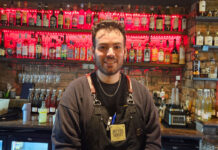There is more choice in commercial microwaves now than there has ever been

FOOD has been one of the big success stories of the licensed trade over the past decade.
In the wake of the smoking ban and, more recently, the lower drink drive limit – and as a sizeable share of the public chooses to drink less alcohol – many operators have had to adjust and expand their offers.
Subsequently, food has become an important part of the offer in many of Scotland’s pubs.
Unsurprisingly, this has had a knock-on effect on the commercial catering equipment industry, with sales continuing to grow.
In fact, according to Panasonic, the non-domestic market is expected to continue to grow until at least 2021.
The equipment itself continues to evolve as well, as manufacturers and suppliers look to provide licensees and chefs with the best equipment for their venues.
Perhaps nowhere is this innovation more apparent than with the commercial microwave, which has seen a number of advancements in technology in recent years.
“Manufacturers are always looking for new and innovative ways that microwave technology can be used,” said Ray Hall, managing director of equipment supplier RH Hall.
Many foods and dishes can be cooked very, very well in a microwave oven, with great results.
“The combination microwave and high speed oven market is continuing to grow – with these clever machines offering the speed of microwave cooking, combined with the versatility of more conventional methods.”
Another recent innovation, ‘inverter technology’, allows for more precision microwave cooking than was previously possible.
John Marks, area sales manager at Stephens Catering Equipment, said: “The inverter technology allows you to cook more precisely and gently compared with traditional microwave ovens.
“The simplest way to explain this would be if you are cooking in a traditional microwave and you choose half power it would pulse at 100% (ie. 1800w) for half the time whereas the new inverter model would be cooking at 900w 100% of the time.”
And it’s not just the functionality that has improved.
According to Iain Phillips, sales and marketing manager at Panasonic UK, the varied size of venues offering food – and the different requirements of those venues – has created a fresh set of challenges for manufacturers.
Used properly, the microwave will form a key part of the kitchen operation.
“The rapid growth in the coffee shop sector and the popularity of ‘grab and go’ food has led to increasing demand for more compact, multifunction catering equipment, to maximise performance in smaller venues, which also includes pubs with challenging kitchen spaces,” he said.
The versatility of the latest microwaves means they are suitable for a range of dishes – including foods that may have previously been considered outwith the microwave’s remit.
“Many foods and dishes can be cooked very, very well in a microwave oven, with great results,” said Hall.
“The most obvious benefit to any operator is speed, but there is a great deal of versatility that a microwave can offer.


“Used properly, the microwave will form a key part of the kitchen operation and the ability to serve a full menu.”
Marks, at Stephens Catering Equipment, agreed.
He said: “With the number of foodservice companies now offering some quality pub classics, such as sausage and mash, beef and ale casserole and lasagne, you can just about cook any pub classic.”
Choosing the right piece of kit for a particular venue is, of course, essential.
With so many models now on the market, it’s important that operators have a clear idea of what their needs are.
Phillips, of Panasonic, said: “Before buying a new microwave, as well as budget, consider the style of food and type of service you want to offer and the space you have available; could you take advantage of a stackable oven and is there suitable extraction?”
The specific dishes being prepared in the microwave will go some way to deciding which type of oven to choose, said Phillips, as certain food types are better suited to certain types of microwave.
He said: “Generally speaking, those dishes with a higher moisture content cook well in a standard microwave; classics such as lasagne, soup, shepherd’s pie, puddings with custard, etc. but the type of microwave oven required will very much depend on the type of food, style of service, volume of business and clientele served.”
To ensure the oven you are considering has enough power, ask for a demonstration.
Hall, of RH Hall, also stressed the importance of choosing the right tool for the job.
“Whilst it is common for caterers to choose speed (the higher the output the faster reheat times), it is also very important to understand that for some food products too much speed will destroy smaller portions of food or the delicate and sugary types of products,” said Hall.
If in doubt it can be an idea to ‘try before you buy’ in order to avoid purchasing a piece of kit that isn’t suited to a particular premises or menu.
Phillips said: “To ensure that the oven you are considering has enough power and variety of programmes for your style of food, ask for a demonstration, cooking items from your menu.”
And operators shouldn’t forget to enquire about the warranty cover for their chosen oven, advised Hall.
“Always check the warranty offering available,” he said.
“A good quality commercial machine should come with a minimum of one year on site parts and labour warranty – with many of the leading manufacturers now offering up to three years.
“Look particularly at the cover offered on the magnetron, which is the heart of any commercial microwave.”




















